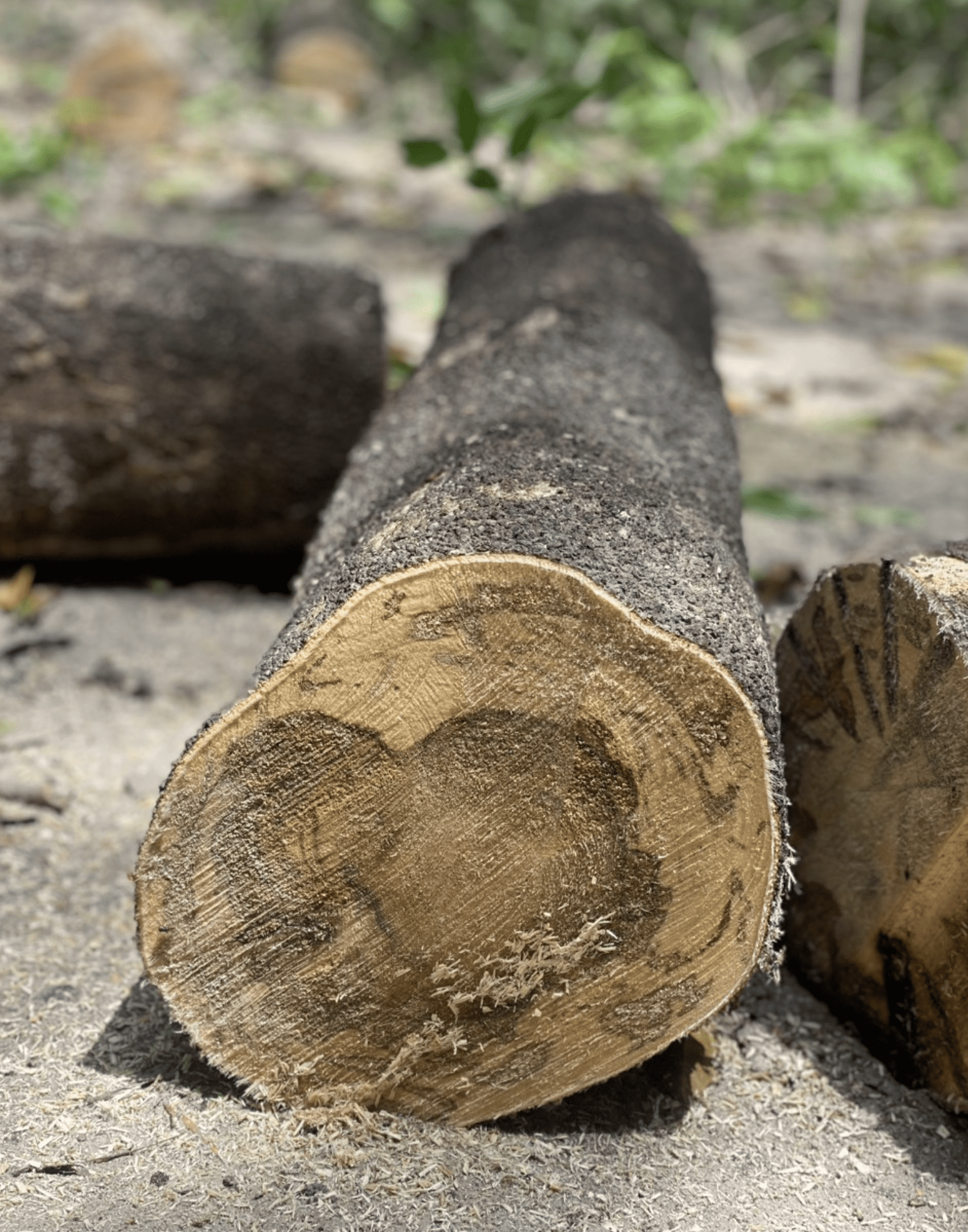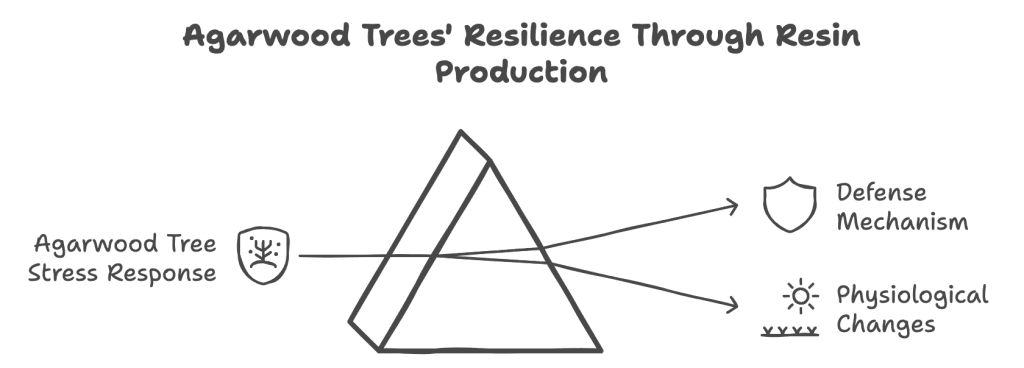
Table of Contents
ToggleI. Introduction
Agarwood, one of nature’s most valuable resins, undergoes a fascinating transformation process inside natural agarwood trees. Understanding the formation process of agarwood is crucial for both conservation efforts and the perfume industry. This article explores the complex journey of how agarwood forms within trees, the biological mechanisms involved, and the factors that influence this remarkable process.

II. The Agarwood Formation Process
A. Causes of Resin Production
Agarwood formation begins when the natural agarwood tree experiences stress, primarily due to fungal infection in agarwood or physical trauma. The most common fungus associated with this is Phialophora parasitica, which infects the tree, triggering the production of aromatic resin as a defense mechanism.
- Fungal infection: The fungus Phialophora parasitica is the main agent causing resin production in agarwood trees. This infection prompts the tree to secrete resin-laden heartwood to protect itself from further damage.
- Physical trauma: In addition to fungal infection, physical trauma caused by storms, pests, or human activities can also induce resin production. These injuries disrupt the tree’s normal processes, prompting the tree to produce resin as a protective response.

B. Resin Accumulation in Heartwood
Once the tree is infected or injured, aromatic resin begins to accumulate inside the heartwood. Over time, this resin saturates the heartwood, transforming it from its original pale color into the dark, dense, and fragrant wood known as resinous heartwood.
- Resin saturation: The process of agarwood formation involves the gradual saturation of the tree’s heartwood with resin. This transformation is essential to produce the highly valuable aromatic resin that makes agarwood so prized.
- Color change: Initially, the heartwood is light-colored and odorless. However, as resin accumulates, it significantly darkens, becoming the distinctive resinous heartwood recognizable in high-quality agarwood.

C. Natural and Artificial Formation
While natural agarwood formation occurs organically through stress and infection, artificial agarwood is produced through inoculation techniques. These methods aim to replicate the natural conditions that lead to resin production, thereby increasing yield and reducing pressure on wild populations.
- Natural formation: This involves the organic response of the tree to fungal infection or physical trauma, resulting in the production of aromatic resin without human intervention. The resin produced during the agarwood formation process contains anti-inflammatory properties beneficial for health.
- Artificial inoculation: The use of agarwood inoculation techniques involves introducing specific fungi or mechanical wounds to stimulate artificial resin production. This method accelerates agarwood formation and increases resin yield.

III. Biological Mechanisms Behind Agarwood Formation
A. Role of Fungi
Fungi such as Phialophora parasitica play a crucial role in agarwood formation. These fungi infect the tree, triggering the production of aromatic resin as a defense mechanism.
- Symbiotic relationship: The interaction between agarwood trees and the fungus Phialophora parasitica is a form of symbiosis, where the fungus benefits from the tree while encouraging the tree to produce resin.
- Primary cause of resin: Fungal infection is the primary cause of resin, leading to the accumulation of resinous heartwood within the tree.
B. Tree Response to Stress
When faced with fungal infection or physical trauma, agarwood trees undergo significant physiological changes to protect themselves. This stress response leads to the production of aromatic resin.
- Defense mechanism: The tree’s production of resinous heartwood acts as a barrier against fungal intrusion and physical damage, ensuring the tree’s survival.
- Physiological changes: These changes include increased resin secretion, altered growth patterns, and modifications to the tree’s metabolic processes to support resin production.

The biological characteristics and classification of agarwood trees provide the foundation for implementing effective sustainable cultivation and harvesting measures.
IV. Factors Affecting Agarwood Formation
A. Tree Species
Different species of Aquilaria have varying resin production capacities. Species such as Aquilaria malaccensis, Aquilaria crassna, and Aquilaria sinensis are renowned for their ability to produce high-quality agarwood resin.
- Species variation: Each Aquilaria species has unique characteristics that affect the quality and quantity of resin produced. Understanding these differences is key to optimizing the agarwood formation process.
B. Environmental Conditions
Environmental factors such as climate, soil type, and altitude significantly influence agarwood formation. Optimal conditions promote resin production, while unfavorable environments can hinder the process.
- Climate: Agarwood trees thrive in tropical climates with high humidity and stable rainfall, conducive to fungal growth and resin production.
- Soil type: Well-drained, organic-rich soil supports healthy tree growth and efficient resin accumulation.
C. Time and Duration
The process of agarwood formation is time-consuming, often taking several years to decades. The duration depends on factors such as the tree’s age, the degree of infection, and environmental conditions.
- Tree age: Older trees tend to produce higher-quality resinous heartwood because they have more established resin production systems.
- Time: The natural accumulation of resin requires patience, making agarwood formation a long-term investment for cultivators and farmers. Understanding the formation process helps explain the factors influencing quality and pricing in the agarwood market.

V. Sustainable Practices and Artificial Inoculation
A. Artificial Inoculation Techniques
To meet the high demand for agarwood, artificial inoculation techniques have been developed. These methods involve introducing fungi or creating controlled wounds to stimulate resin production.
- Inoculation methods: Techniques such as drilling holes into trees and introducing Phialophora parasitica or other beneficial fungi are commonly used to produce agarwood.
- Controlled environment: Artificial inoculation allows for timely and predictable resin production, ensuring a stable supply of aromatic resin.
B. Benefits of Artificial Methods
Artificial agarwood production offers several advantages over natural methods, including increased resin yield, reduced resin accumulation time, and decreased reliance on wild populations.
- Higher yield: Artificial methods can significantly boost the amount of aromatic resin produced, meeting market demand more efficiently.
- Conservation benefits: By reducing pressure on wild agarwood trees, artificial inoculation supports conservation efforts and helps prevent overharvesting.
VI. Ecological Impact of Resin Production
A. Conservation Concerns
High demand for agarwood has led to overharvesting, putting many Aquilaria species at risk. Sustainable practices are essential to protect these valuable trees and their ecosystems.
- Endangered species: Several Aquilaria species are now classified as endangered due to excessive logging and habitat loss.
- Conservation efforts: Initiatives such as regulated harvesting, plantation cultivation, and sustainable practices are crucial for preserving agarwood trees.
B. Balancing Economic and Ecological Needs
Achieving a balance between economic benefits and ecological sustainability is critical for the future of agarwood. Sustainable harvesting and responsible cultivation practices ensure that agarwood trees continue to thrive without compromising their ecological role.
- Sustainable harvesting: Implementing guidelines and regulations for agarwood harvesting helps maintain healthy tree populations and ecosystems.
- Economic importance: Ensuring the economic viability of agarwood production through sustainable methods supports local communities and industries without depleting natural resources.

VII. Conclusion
The process of agarwood formation is a remarkable natural phenomenon, highlighting the complex relationship between fungal infection and the tree’s resilience. Understanding this process is essential for both the conservation of agarwood trees and the continued prosperity of the perfume industry.
As demand for aromatic resin grows, adopting sustainable practices and utilizing artificial inoculation techniques are imperative to ensure that agarwood remains an essential part of our natural and economic landscapes. By balancing economic needs with ecological sustainability, we can preserve this precious natural resource, in line with a comprehensive overview of agarwood trees.
Frequently Asked Questions:
- What triggers resin formation in agarwood trees?
Resin formation in agarwood is primarily triggered by stress factors, such as fungal infection (especially Phialophora parasitica) or physical trauma caused by storms, pests, or human activities. These stressors activate the tree’s defense mechanism, leading to resin production. - What role does Phialophora parasitica play in agarwood formation?
Phialophora parasitica is the primary fungus responsible for initiating resin production in agarwood trees. When this fungus infects the tree, it stimulates the tree to produce resinous heartwood as a defense against the intrusion. - How does resin accumulation transform the heartwood of agarwood trees?
Resin accumulation begins when the tree is stressed by infection or injury, gradually saturating the heartwood with resin. This process transforms the heartwood from a pale, odorless state into the dark, dense, and fragrant resinous wood highly valued for its aroma. - What is the difference between natural and artificial agarwood formation?
Natural agarwood formation occurs as the tree responds organically to stressors like fungal infection or trauma. In contrast, artificial formation involves techniques such as inoculation or mechanical wounding to deliberately stimulate resin production. Artificial methods aim to increase resin yield and reduce pressure on wild populations. - Why is understanding the agarwood formation process important for conservation and industry?
Understanding the agarwood formation process is crucial for developing sustainable cultivation and harvesting practices, improving resin yield, and ensuring the conservation of agarwood trees. This knowledge supports the perfume industry in meeting demand responsibly while protecting natural populations and their ecosystems from overharvesting.
Author
Tran Thi Bich Ngoc is the Head of Production at Oudgo, overseeing the entire production process from agarwood harvesting to processing and packaging the final products. She holds a Bachelor’s degree in Biotechnology from Hanoi University of Science and Technology and brings over fifteen years of experience in the agarwood production industry. Prior to joining Oudgo.Ms. Ngoc worked with companies specializing in the production of natural cosmetics and health care products. Her extensive expertise ensures the highest quality and efficiency in Oudgo’s production operations, contributing significantly to the company’s reputation for excellence see more
